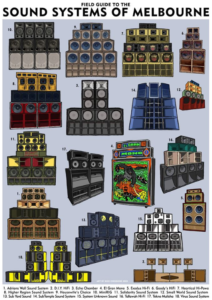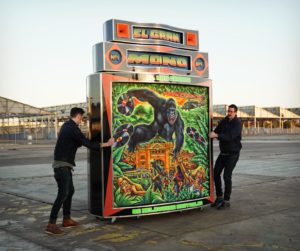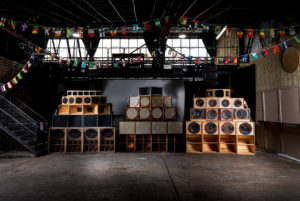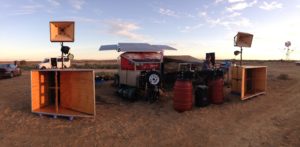Introduction to Sound System Culture in Melbourne
This blog inaugurates a new series which will be featured on the SST blog, introducing sound systems and other SST cultures in different cities and countries around the globe. Written by researchers who share a first-hand knowledge of the local scenes, they have to be considered as field notes from the ongoing SST research – departure points rather than culminations – which purpose is to showcase the richness of the global diaspora of the sonic street technologies, raise interest and foster connections. First on the series is Melbourne, Australia.
—
The history of sound system culture in Melbourne (and indeed Australia), is rich and diverse, yet on a continent largely dominated by rock music it has received little attention from the media or scholars [1]. Meanwhile, over the last decade more than a dozen sound systems have been built in Melbourne alone, a city of 5 million inhabitants which has prided itself on being Australia’s premier destination for live music. The local proliferation of sound systems was set to culminate in 2021 with an event called Heavy Congress, which was set to bring together no less than eight sound systems (most of those in the Main Hall of the Melbourne Town Hall). However, another Covid-19 lockdown was announced just a few days before that event, and like so many other dances during the pandemic, it had to be cancelled.
Heavy Congress was billed as the biggest ever sound system event to happen in Australia, in terms of the number of participating sound systems. Even more significantly however, this event – or ‘session’ – was also set to reflect the ‘outernational’ diversity of Melbourne’s sound system culture, as Jamaican-styled dub and reggae ‘sets’ to ‘free tekno’, drum n’ bass/jungle focused sound systems to an Afro-Colombian picó playing champeta, cumbia, salsa and soukous, were all brought together to play in the same hall. The main influence on Melbourne sound system culture has come via the UK, with the influence of Jamaican-style dub-reggae sound systems dominant. However, there is also a very strong influence of ‘free tekno’ sound system culture, albeit these sounds don’t all necessarily play ‘tekno’. Then there are other emerging outernational influences from the non-English speaking world, such as the Colombian-style picó.
This article provides a short overview of sound system culture in Melbourne, contemplating some of the broader socio-cultural and indeed political potential of sonic street technologies in Melbourne (and Australia). It’s difficult to imagine an event celebrating the diversity of sound system cultures at this scale to come to fruition again any time soon, but it very nearly happened in Melbourne. This article therefore makes a unique contribution in imagining a dance – or ‘session’ – featuring parallel sound system cultures performing for a single dancefloor ‘massive’.
Field Guide to the Sound Systems of Melbourne and Heavy Congress
The spark for Heavy Congress was the Field Guide to Melbourne Sound Systems poster, published in early 2020 as a tribute to recognise the growing number of custom-built sound systems built in Melbourne (Figure 1). This poster was commissioned by local Melbourne record collectors and DJs Tom Noonan and Johnny el Pajaro, who are behind El Gran Mono, the first picó sound system built outside Colombia which was completed in 2018 (Figure 2). Based on the UK Sound Guide [2] and other similar sound system pictorials, it was illustrated by Rick Chesshire from Geelong, Australia.

Figure 1 – Field Guide to the Sound Systems of Melbourne poster by Rick Chesshire. Courtesy of El Gran Mono.
This poster is an important catalogue of sound systems in Melbourne, and visualizes the diversity of parallel sound system cultures from around the globe which have made local impact. El Gran Mono, for example, was inspired by, designed and built in collaboration with several protagonists of the picotera culture on Colombia’s Caribbean coast. Accordingly, the music performed on this sound are predominately champeta, cumbia, and the broader African and Latin American associated with picós in Colombia [3].
Whilst the owner-operators don’t have Colombian heritage, they have made great efforts to represent this Afro-Caribbean culture ‘outernationally’, by hosting sessions featuring selectors who are able to connect with the large Colombian diaspora in Melbourne and the wider community. It can be claimed each individual sound system in Melbourne is similarly connecting with and building a particular community, and collectively they constitute a significant cultural movement which the Field Guide has aimed to communicate. This, of course, also largely represents the mission of the Sonic Street Technology research project.

Figure 2: El Gran Mono and its owner-operators. Photo by Melissa Hilton.
The Field Guide to Melbourne Sound Systems poster was prominently displayed at Northside Records, which as well as a record store and label, can be considered a community hub priding itself in disseminating and supporting the releases of local music producers. Store owner and DJ Chris Gill made a couple of calls to some curators, which led to an event called Heavy Congress being proposed to be included at the inaugural Rising festival [4]. It received great media attention and the event sold out as soon as it was announced. Programmed for June 2020 and sponsored by the City of Melbourne, Rising aimed to celebrate Melbourne’s re-emergence from the endless Covid-19 imposed lockdowns on the city which have ravaged the local music scenes.
But another outbreak of Covid-19 in late May 2020 meant another lockdown was imposed, and the Rising festival was cancelled. Then the Delta variant arrived, and Melbourne is yet to rise and re-establish itself as Australia’s premier city of live music. Despite live sessions currently not being possible, local sound system crews have been refining and expanding their systems, and indeed new sets keep being built. It’s beyond the scope of this blog post to investigate all the various motivations which led to such a proliferation of sound systems in Melbourne, but it is important to establish a sense of the diversity of local sound system culture in this brief overview.
There are eighteen sound systems featured on the Field Guide poster, and the El Gran Mono website has extra details on some of them [5]. Built by Derek Marr a.k.a. Stryka D in 2006, Heartical Hi-Powa is one of Melbourne’s first reggae and dub-oriented sound systems. Inspired by London’s Notting Hill Carnival, Marr began building Heartical Hi-Powa shortly after arriving in Melbourne from his native Liverpool in 2002 [6].
The experience of Notting Hill Carnival also inspired Adrian Hough in High Wycombe, UK to build his Adrian’s Wall Sound System, and began hosting sessions in 2008 until emigrating to Melbourne in 2011. The first local show of Adrian’s Wall Sound System was alongside Heartical Hi-Powa in May 2012, reputed as Australia’s first event with two sounds in the one room. These two sounds are known for being faithful to the Jamaican roots of what they had experienced in the UK, and the love for reggae and dub is evident in most of the other Melbourne sound systems. This includes Housewife’s Choice, built by the female selector-duo Miss Fee and Bellyas and launched in March 2021 as part of Adrian’s Wall’s long-running ‘Forward Ever’ sessions (Figure 3).

Figure 3: Adrian’s Wall, Housewife’s Choice and Goody’s HiFi set up for Forward Ever session in Melbourne on 26 March 2021. Photo by Francesco Vicenzi.
This dance also featured Goody’s HiFi, another recently established sound system named in recognition of Graeme “Goody” Goodall, radio technician from Melbourne, who arrived in Jamaica to build the country’s first FM station and stayed, becoming instrumental in setting up most of the best known Kingston recording studios and reggae labels, including as a co-founder of Island Records [7]. The operators of Goody’s HiFi – Jack Walters and Harrison Kewley – had first been inspired at local sessions hosted by Heartical Hi-Powa and Adrian’s Wall. This is also what several other newer sound system operators who feature in the Field Guide will tell you, as inspired to build their own sound systems after having attended local Melbourne dances.
Heartical Hi-Powa and Adrian’s Wall, and likewise El Gran Mono with Afro-Colombian musical culture, strongly identify through their musical selections with the very particular cultures of Jamaica (albeit via the UK) and Colombia, and arguably make significant contributions to social and racial cohesion of the hugely diverse immigrant communities which make up contemporary Melbourne. However the Field Guide poster also includes a number of pioneering sound systems with roots in the UK’s 1980s ‘free tekno’ movement which are less faithful to particular cultural origins and musical aesthetics, and must also be considered for their hugely influential role in Melbourne (and Australian) sound system culture.
Free Tekno and Earthdream 2000
Electronic dance music festivals were initially experienced as a ‘free’ alternative to the proliferation of commercial rock music festivals in the UK during the 1980s, taking place in urban warehouse occupations and squatted spaces and the countryside. By the early 1990s, loosely connected sound system crews had come to represent a ‘free tekno’ movement, as what had come to be recognised as techno was increasingly commercialised and unregulated raves became criminalized by the government. The ‘free tekno’ sound systems are not considered as part of the Jamaican diaspora, but even those playing ‘tekno’ generally profess having been influenced by Jamaican reggae roots culture, and most significantly embody the sound system ethos of creating and defending cultural spaces. Several of these crews left the UK for a nomadic existence across Europe, and in 1999 a group arrived in Australia including the European sound system rigs of Bedlam and Negusa Negast, to take part in the epic ‘free tekno’ event Earthdream2000 in outback central Australia [8]. Australian crews Labrats and Ohms not Bombs were the local collaborators, as well as Melbourne-based veteran of the ‘free tekno’ movement Robin Cooke (of the Mutoid Waste Co.), who had emigrated from the UK some years earlier.
The D.i.Y. HiFi sound system is featured on the Field Guide to Melbourne Sound Systems, and its three owner-operators met at Earthdream 2000. D.i.Y. Hifi prides itself on being solar-powered and possible to operate completely off-grid, reflecting the ‘free tekno’ ethos of its builders: engineer Richie A, sound engineer Phil B and DJ/producer Monkey Marc (originally of Labrats) [9]. Other ‘free tekno’ sound system featured on the Field Guide, are Virus Sound System (VSS) and Tekno Mulisha. VSS was first built in early 2000s, but then placed in storage and eventually sold as its builder Chris “Virus” left Australia for several years. Upon his return, he rebuilt Virus in 2016 and is now going strong with the same political energy which had motivated the original system [10].
Activism through dance music culture informs the ethos of these sound system crews, and this is the subject of the book Free Nrg: Notes From the Edge of the Dancefloor (2001), edited by Graham St John. The influence of Jamaica, via the UK, is prevalent in this anthology of late 1990s Australian popular music history, which reflects different ways of knowing, as it is authored mostly by the sound system crews and other protagonists. St John’s analytical chapters in this seminal anthology aim to differentiate the unique characteristics of Australian sound system culture versus the UK roots, and concludes this to be the way it has become a medium for addressing the legacies of colonialism, in coming to terms with the (ongoing) destruction of the culture of Aboriginal people and the environment [11]. St John’s early 2000s scholarship on what he considered as Australian post-rave culture, deserves to be reappraised as having made a significant contribution to the outernational histories of sound system cultures. The ongoing legacy of some ‘free tekno’ crews (or indeed ‘tribes’ as St John calls them) is also worthy of further study, as they are still active today and some are even featured on Field Guide to Melbourne Sound Systems poster.

Figure 4: The solar-powered D.i.Y. HiFi sound system set up for Burnout 2016 at Mutonia Sculpture Park, Alberrie Creek, South Australia. This was also the site for Earthdream2000. Photo by Marc Peckham.
The Future of Sound System Culture in Melbourne
The Field Guide catalogues history in the making, and whilst Melbourne may have become the continent’s most prolific site for sound systems, there are more histories across Australia. For example, Jamaican immigrant JJ Roberts built Australia’s first reggae sound system in early 1970s Sydney [12]. Another immigrant from the UK, Milton Westcarr, who had operated Jah Trinity Sound in Gloucester, arrived in Adelaide to build Earthshaker in the early 2000s.
The event Heavy Congress could have been, is likely to be resurrected when this becomes possible again. Whilst Covid-19 lockdowns have prevented local sound system sessions from happening, it is a good time to further ponder the legacy and future of sound system culture in Melbourne, and indeed across Australia. Unlike in Jamaica, Mexico or Colombia for example, sound system culture does not appear to have emerged from the needs of an oppressed majority to culturally express themselves. Neither does it appear to have been fuelled by large immigrant communities creating spaces to connect with the diaspora large and significant enough to spark a broader societal change, as it did in the UK for example. Instead, a number of pioneering committed collectives and individuals have stoically been building community by investing their lives and fortunes into sonic street technology, and creating alternative spaces which are increasingly gaining their own momentum.
Moses Iten is a DJ (selector)/ producer and PhD candidate at RMIT, Melbourne, researching digital cumbia and sound system culture. He performs around the world as Cumbia Cosmonauts. In Melbourne he is a frequent collaborator with D.i.Y. HiFi sound system, and has featured as a guest selector with El Gran Mono, Higher Region Sound System, and danced to many of the others.
—
References
[1] Big up Adrian Hough of Adrian’s Wall sound system, whose presentation ‘A Brief History of DIY Sound System Culture in Australia’ and subsequent personal communications were very useful in guiding this article. Hough’s brief history was first presented at the Global South Popular Music Perspectives Symposium at RMIT, Melbourne, on 28 February 2020.
[2] See https://wrapupadraw.bigcartel.com/product/uk-sound-guide-a3-print
[3] El Gran Mono owners-operators Tom Noonan and Johnny el Pajaro pay special tribute to the collaborative efforts of Fabian Altahona Ramirez and the renowned visual artist William “El Maestro” Gutierrez Peñaloza, whose painting adorns El Gran Mono. Both of these collaborators are well-known protagonist of their local scenes, and based in Barranquilla, Colombia. See https://elgranmono.com.au/OUR-STORY-NUESTRA-HISTORIA
[4] See https://rising.melbourne/festival-program/heavy-congress
[5] See https://elgranmono.com.au/SOUND-SYSTEMS-OF-MELBOURNE
[6] For an interview with Derek Marr from 2014, see https://youtu.be/EALbF8AeeZc
[7] Michael Veal called Mr Goody “an unsung hero of the Jamaican recording industry” (Veal 2007: 49-50). Also see David Katz’ obituary of Graeme Goodall: https://daily.redbullmusicacademy.com/2014/12/graeme-goodall-rip
[8] See the documentary Earthdream 2000 (2004) by Matt Bonner at https://youtu.be/6AjshqIrpA8. Also see the documentary Do It Ourselves Culture (2014) at https://ohmsnotbombs.net/culture. The history of ‘free tekno’ in the UK and its subsequent travels across Europe and especially to Australia, are comprehensively analysed by Graham St John in the book Technomad: Global Raving Countercultures (2009).
[9] See https://diyhifi.biz/
[10] See short interview with Chris “Virus” in a video produced by Francesco Vicenzi for Heavy Congress at https://youtu.be/0it34cD0ceQ
[11] Also see Graham St John. 2005. ‘Outback vibes: sound systems on the road to legitimacy’ in Postcolonial Studies, 8:3, 321-336, http://dx.doi.org/10.1080/13688790500231020, and Graham St John. 2010. ‘Making a Noise – Making a Difference: Techno-Punk and Terra-ism’ in Dancecult: Journal of Electronic Dance Music Culture, 1(2), 1-28. http://dx.doi.org/10.12801/1947-5403.2010.01.02.01
[12] For more on JJ Roberts and the history of reggae in Australia, see Brent Clough. ‘From our brother: Reggae downunder’ in Seth Jordan (edited by). 2010. World Music: Global sounds in Australia. Sydney: UNSW Press. 85-106.
